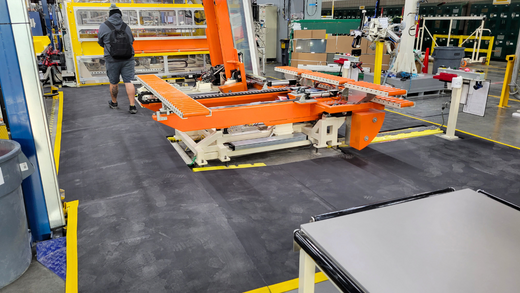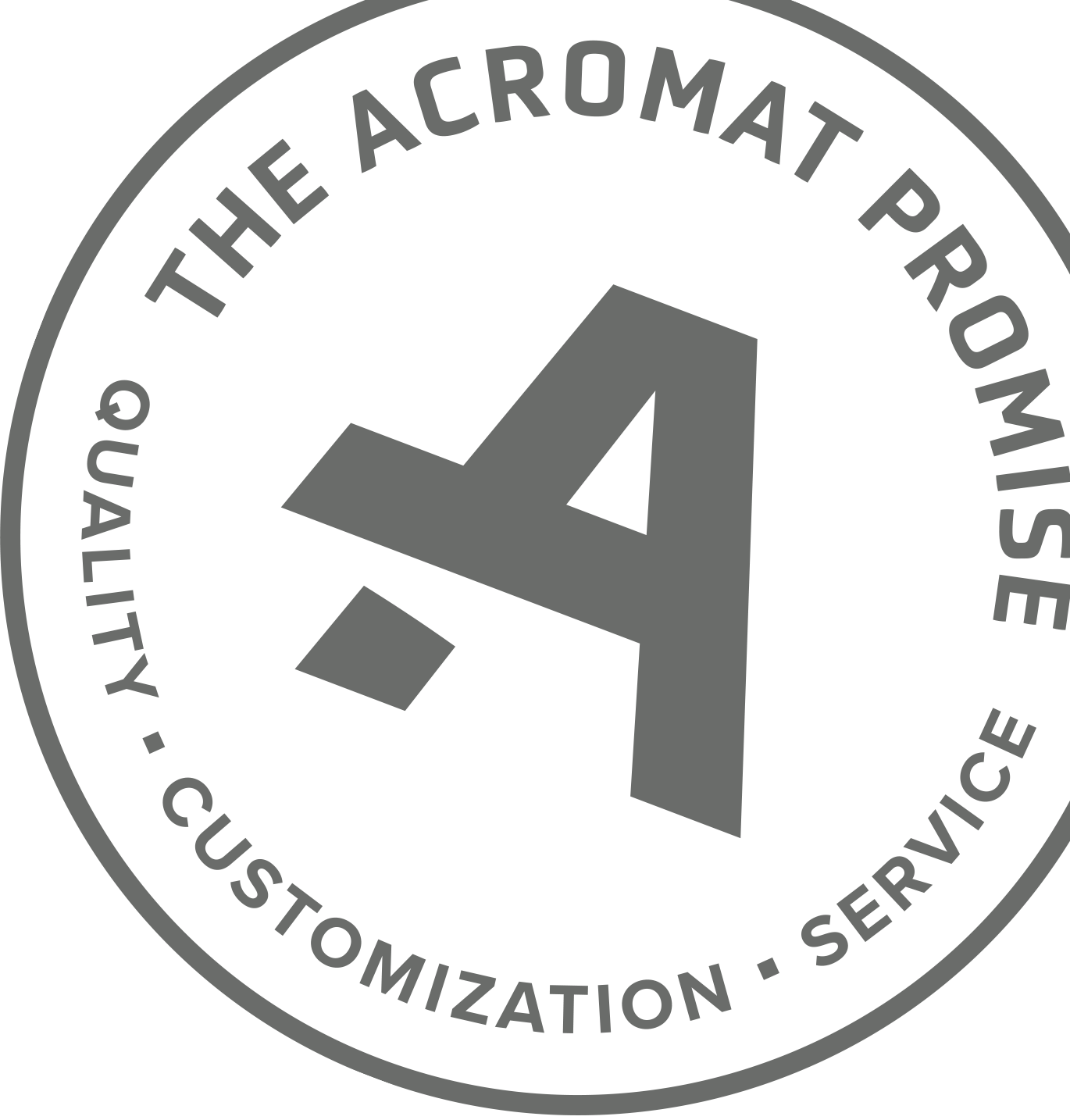Proactively cleaning your AcroMat anti-fatigue mats can extend their useful life by up to an entire year and also ensures they perform as intended. But both have to be done right.
Here are 8 anti-fatigue mat care and cleaning tips to maximize the lifespan of your mats, to protect your people, and to reduce constant re-purchases years before necessary.
1. Rotate Your Mats to Low-Traffic Areas
Anti-fatigue mats are like tires on a vehicle; they’re an investment. The better you take care of your investments, the better they perform and longer they last. Like rotating the tires on your vehicle every few thousand miles, rotating your heavily used mats to lower-traffic areas can extend their functional lifespan.
For example, if you recently purchased 10 3 ft. by 5 ft. mats for a high-traffic area and have several 3 ft. by 5 ft. mats in use in a low-traffic area, consider rotating them every so often. If you have an operator who works predominantly on one end of a long runner, flip the mat 180 degrees every 90 days to reduce the overall wear on any one area.

Winnebago rotates this AcroMat custom 100-1 Series mat 180 degrees every few months to evenly spread out wear and extend useful life. AcroMat-Winnebago case study.
2. Clean with Standard Procedures
Before cleaning your anti-fatigue mats, it's important to first determine what they are made from, whether they are chemical resistant and waterproof, and how the manufacturer of the mats recommends cleaning their products.
AcroMat Cleaning Procedures
The AcroMat 100-1 Series, 100-ESD Series and 100-Cleanroom Series mats are made from molded, closed cell, 100% nitrile rubber, which can be scrubbed, broomed, deck brushed, wiped, mopped or even pressure washed without fear of the material breaking down. Industrial strength cleaners like ammonia, bleach, degreaser, warm soapy water, and disinfectants work well and will not absorb into the material.
Pure nitrile is unique in that – unlike extruded PVC foam mats and PVC/nitrile blends – it’s completely impervious to liquids and chemicals.
Related: The Best Anti-Fatigue Mat Material: 100% Nitrile vs. PVC Foam
The AcroMat NitriTuf Diamond Series mat is made from closed cell, NBR rubber foam. While closed cell and chemical resistant, we recommend brushing, brooming, mopping and/or wiping the diamond tread surface rather than soaking it with liquids for long periods. Gentle cleaners are encouraged. The NitriTuf Diamond Series is ideal for dry/dusty environments, and we encourage a similar cleaning process for this mat.

The AcroMat NitriTuf Diamond Series is designed for dry settings, and best cleaned with brooms, brushes, and mops.
The AcroMat X60-Series, designed for areas where durability isn't as pressing, can be brushed, broomed, mopped or wiped to clean the top and bottom surfaces. While closed cell, the NBR rubber foam is not designed to handle chemicals in the same way as our 100-Series mats.
Gentle Vacuuming Works Well
For all AcroMat mats, gentle vacuuming is another cleaning option. However, it's important to be gentle around the edges and along the surfaces, and to make sure no sharp objects from the vacuum pierce the material. Hand-held hoses or portable vacuums are ideal.
Pro Tip: Use Microfiber Rags
Microfiber rags and mopheads are encouraged when cleaning any anti-fatigue mat. Unlike standard rags and mops, microfiber materials will not leave behind lint and other material from the fabric on the mat.
Always Check With the Provider or Manufacturer
If your anti-fatigue mats are not AcroMat brand and you learn they extruded, open cell, and made from a PVC foam material, it's important to check with the provider for cleaning instructions to avoid wearing the mat down. One reason we makes our mats from molded, closed cell, 100% nitrile is because of how cleaning strengthens the mat and extends the useful life. With PVC foam and PVC/nitrile blends, there is often fear of the fabric corroding.
 The AcroMat 100-1 Series mat is made from 100% nitrile, which is impervious to liquids and chemicals. The borders are molded yellow, meaning they will not fade over time like painted on borders and tapes. If the yellow looks faded, it likely just needs a good scrub.
The AcroMat 100-1 Series mat is made from 100% nitrile, which is impervious to liquids and chemicals. The borders are molded yellow, meaning they will not fade over time like painted on borders and tapes. If the yellow looks faded, it likely just needs a good scrub.
3. Remove Particle Build-up Under Your Mats
Dust, dirt, chemicals, metal shavings, food products and even nuts, bolts and washers not only accumulate over time but they can eat into the fabric of your anti-fatigue mats. They can also cause slip hazards because they lift the fabric off the ground, reducing its grip on the floor. In addition to cleaning your mats regularly, it's important to clean under and around your mats to make sure they stay free from build-up.
4. Address Rips and Tears Quickly
There is a secret most mat providers don't want you to know: Premium mats can often be repaired if there is a rip, tear, aged section, or if you want to repurpose the mat for another area. You don't always have to buy new. This is certainly true with AcroMat anti-fatigue mats.
Minor damage to AcroMat anti-fatigue mats can be easily repaired in minutes with the AcroMat Repair Kit. If you have a major need, like a layout change or new equipment entering a cell, you send your mat back to our team and we will adjust or update the mat free of charge; customers only pay for the extra material.

This AcroMat client moved equipment in a custom-design spaced and thus needed their AcroMat mat extended to properly fit. They send it to our team, we added the addition in less than 5 days, and the mat was quickly back on-site and in action.
In this timelapse, AcroMat General Manager Russell Herbert shows how our bonding adhesive – what we use to make our custom mats and what comes with our Repair Kit – restores damaged AcroMat mats to like-new in minutes.
5. Conduct Regular Inspections
Regular mat inspections are like preventative health check-ups for your facility. They help you identify problem areas before they arise. Yet, 55% of our audience says they don’t have a formal anti-fatigue mat inspection process. Another 21% says they are unsure.
Proactive inspection give you the information you need to avoid reactive purchases, over-spending, and mats that wear out too quickly. It also allows your to prioritize what's been discussed above, including early repair and consistent cleanings.

Short on time? Kickstart your anti-fatigue mat inspection efforts with our Anti-Fatigue Mat Performance Snapshot, available on the eBooks & Downloads page.
A Lean 5S tip we received from a Fortune 500 client was to dedicate an operator to walk your facility floor once every month to note any trip, slip, fall or ergonomic hazards that are clear to the eye, any mats that need to be repaired, and any areas that are particularly dirty.
The industrial manufacturer uses these inspections as an opportunity to increase collaboration across their large facility. They also rotate employees every few months to give all team members the opportunity take on new responsibilities that help them work toward growth.
Related: Anti-Fatigue Mat Inspection in 6 Easy Steps
6. Avoid Leaving Heavy Equipment on Your Mats
Heavy equipment, sharp table legs and narrow chairs can create irreparable divots and holes in your anti-fatigue mats. Make sure to roll heavy carts and chairs off of your mats at the end of shift. Another option is to design custom cutouts into your mats to avoid having to place chairs and other heavy equipment on your mats.

Medtronic designed this custom 100-Cleanroom Series mat to prevent heavy, narrow chair wheels from damaging the mat. The ADA-Compliant yellow borders allow the chairs to seamlessly roll onto the mat as needed.
7. Completely Dry Your Mats After Cleaning
Wet mats can slip and slide – reducing worker safety – and can be more easily damaged over time. You can lay wet mats over cleaning carts, clean recycling dumpsters or other immobile equipment to dry after hosing or pressure washing. Some mats also come with grommets to hang them during the drying process.
8. Color Code to Avoid Cross Contamination
Use different color mats for the various locations within your organization to avoid cross contamination with hazardous products like raw meat, potentially toxic chemicals or metal shavings that may find their way onto workers’ shoes, boots, and equipment – especially if there are mats of the same size and shape in hot or warm zones that might be cleaned and rotated with mats from cold zones.

Tyson Foods orders multiple colorways from AcroMat to make sure the correct mats are always returned to the appropriate area after cleanings. This has helped their team avoid cross contamination and ensures the mats last the expected 5+ years.
Premium anti-fatigue mats help prevent injuries, improve employee performance, and can even elevate morale. They also show your workforce that you value their safety and personal well-being. By taking care of your anti-fatigue mats, you're taking care of your people. You're ensuring they last as long as intended. And you're protecting your budget.





